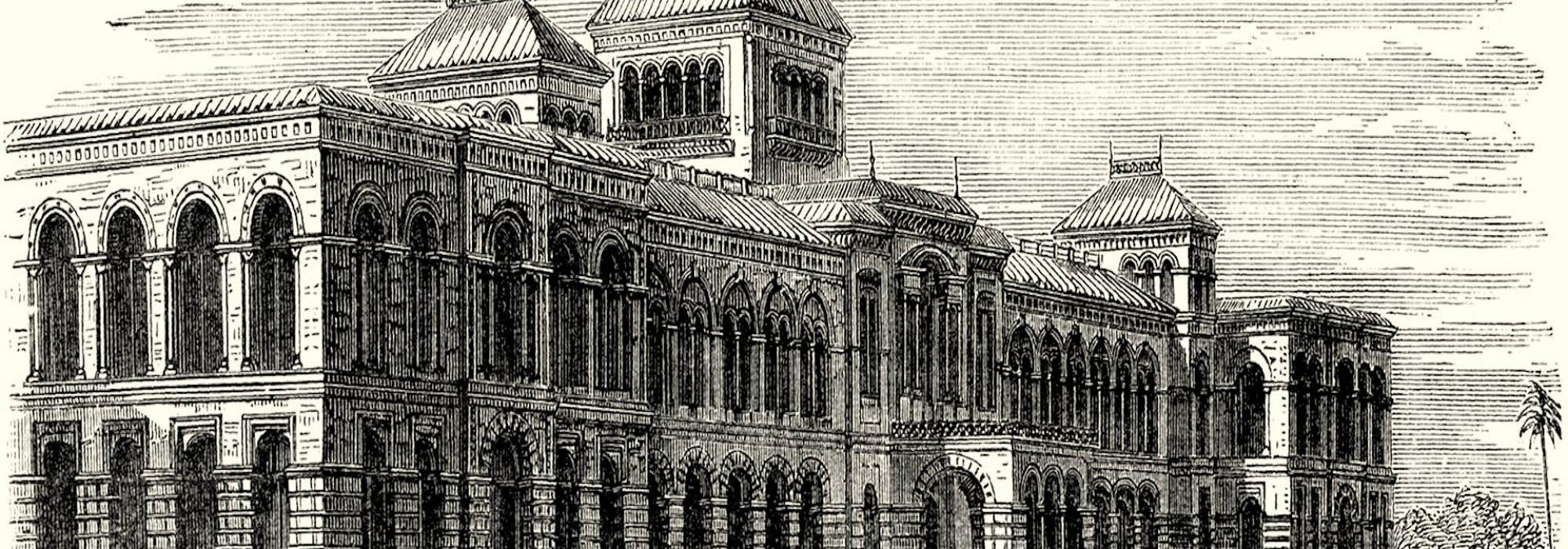An eminent man of letters and a well-known personality, whom I loved and respected as an elder brother (Dr. B K Narayana Rao) would often say this about his guru: the positive influence that Garani Krishnacharya’s personality had on him was unmatched. Krishnacharya’s scholarship was great but even greater was the beauty of his character. He was elegant both outside and within. Everybody felt the need for his presence, his friendship, and his conversation.
Garani ‘Vaiyakarani’ Krishnacharya was a Kannada scholar for many years at the Madras Christian College and afterwards in Central College, Bangalore. He had attained fame because of his books and articles in Sanskrit and Kannada.
Krishnacharya was born on the day of Vaishaka Shuddhapadyami of the Nala samvatsara, which corresponds to the year 1855. His grandfather was ‘Mahishura Puravasi’ ‘Srimadvaiyakarana’ Vyasa Krishnacharya. [Mahishura Puravasi = ‘resident of the town of Mahishura’ and Srimadvaiyakarana = ‘honorable grammarian’]. His father was ‘Parigipuri Sannihita Garani Gramavastavya’ ‘Vaiyakarani’ Timmannacharya. [Parigipuri Sannihita Garani Gramavastavya = ‘resident of the village of Garani, which is close to Parigipuri’ and Vaiyakarani = ‘grammarian’].
Sanskrit grammar was the ancestral property inherited by Krishnacharya. Under the tutelage of his father Timmannacharya, he studied grammar texts like Siddhanta Kaumudi and attained mastery over them. In Kannada literature, his guru was Siddhanta Subramanya Shastry of Bangalore, a preeminent scholar, who had performed jnana-seve (‘the service of knowledge’) to the people of his time by writing verses, prose, poetry, and commentaries. His son was Mahamahopadhyaya Siddhanti Shivashankara Shastri, who was the president of the ninth Kannada Sahitya Sammelana held in Bijapur in 1923. He was also a close friend of Krishnacharya.
The books that Krishnacharya wrote can be divided into four broad categories:
- Sanskrit Grammar
- Kannada Poetry
- Works on Dharma
- Works on Health
Krishnacharya’s first book, written when he was just 23, was the Sanskrit treatise ‘Shabdaratnavali’ (1878). This treatise has been reprinted many times. It is an introductory guide to those who wish to learn Sanskrit. It offers concise and comprehensive structural information about the various aspects of the Sanskrit language like ನಾಮಪದ (noun), ಸಂಧಿ (joining words), ವಿಭಕ್ತಿ (cases), ಸಮಾಸ (compounding of words), ಧಾತು (root words), and ಆಖ್ಯಾತಪ್ರತ್ಯಯ (verbal suffixes). The structure, design, and treatment of the topics in the treatise have reduced the difficulty of the subject. It is Krishnacharya’s astuteness that has helped in conveying much using little space and in sagacious organization of the work. This composition is such that he has given merely what is necessary – not more, not less – but hasn’t left any opportunity for doubt or ambiguity. It appears that while this treatise was published, he had already begun working on his second book, ‘Dhaturatnavali,’ which came out in 1889. The credit for the composition is given to ‘ಸಿದ್ಧಾಂತಿ ಸುಬ್ರಹ್ಮಣ್ಯಾರ್ಯ – ವಿದುಷಾಂ ಪ್ರೇರಣಾಬಲಾತ್’ (Siddhanti Subrahmanya – By the strength of the inspiration of the wise). Further:
ಧಾತುರತ್ನಾವಳೀನಾಮ್ನಾ ತನ್ಯತೇ ಪಿತುರಾಜ್ಞಯಾ |
ಕೃಷ್ಣೇನ ಬಾಲಬೋಧಾಯ ಧಾತೂನಾಂ ರೂಪಪದ್ಧತಿಃ ||
(Loosely translates into: “This work titled ‘Dhaturatnavali,’ a result of my father’s wishes, brought out by Krishna as a primer for children to learn the various forms of root words.”)
This treatise has been reprinted time and again. It is immensely helpful to students of Sanskrit.
It seems that in Kannada Krishnacharya wrote three works of prose, three plays, and one work on alankarashastra (poetics and aesthetics). The works of prose are concise translations of renowned Sanskrit poems and plays:
- A Biography of Nagananda (also known as Jimutavahana)
- The Story of the Mrcchakatika (Sanskrit play)
- Summary of the Kadambari (Sanskrit prose-poem)
I’ve heard that when Krishnacharya was 32 (in 1887), he translated the entire Sanskrit play Nagananda into Kannada. I have not been able to lay my hands on that book. I have also not found a copy of one of his one act plays, ‘Srungara Tarangini.’ His work ‘Samagra Mrcchakatika Prakarana’ was published in 1890.
ಶ್ರೀಮತ್ ಕೃಷ್ಣ ಪದಾರ್ಚಕ |
ಭೂಮೀಸುರವರ್ಯ ಗರಣಿ ಕೃಷ್ಣಾಚಾರ್ಯಂ ಶ್ರೀ ||
ಚಾಮೇಂದ್ರ ಕೃಪೆಯನೆಳಸುತ— |
ಲೀ ಮೃಚ್ಛಕಟಿಕಮನಿಂತು ತಾಂ ಪ್ರಕಟಸಿದಂ ||
(Loosely translates as: “Offering to the feet of Lord Krishna, the eminent brahmana Garani Krishnacharya, by the grace of Sri Chamendra [Chamarajendra Wodeyar], now presents the Mrcchakatika.”)
He says that this play is ‘ಶೂದ್ರಕ ನೃಪತಿ ಪ್ರಣೀತಮುಂ, ರಸಾಲಂಕಾರ ಭರಿತಮುಂ, ಲೋಕಾನುಭವ ನೀತಿ ಬೋಧಕಮುಂ’ – “Written by King Shudraka, filled with the embellishment of rasa, and instructive in worldly ethics.” He calls his own work as being ‘ಪಳೆಗನ್ನಡ ಪೊಸಗನ್ನಡ ನುಡಿಗಳಿಂ ಕಡುಚೆಲ್ವೆನಿಸಿ ಕಾಂಗೊಳಿಪಂತೆ’ – ‘seemingly a spill of words from both Classical and Modern Kannada.’
It is said that Krishnacharya translated Dandi’s Kavyadarsha into Kannada but I have not come across a copy of it.
This is the first part of a two-part translation of the ninth chapter from D V Gundappa’s magnum-opus Jnapakachitrashaale (Volume 1) – Sahiti Sajjana Sarvajanikaru. Translator’s notes in square brackets.














































